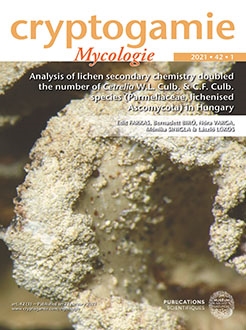The distribution patterns of lichen secondary metabolites are often taxon specific. They represent cryptic chemical diversity additional to morphological-anatomical biodiversity. Cetrelia W.L. Culb. & C.F. Culb. species (c. 200 specimens) were checked and revised by thin-layer chromatography. Soredia, pseudocyphellae, rhizines, features of lower surface are the main morphological characters analysed against the presence of cortical pigment, atranorin and medullary α-alectoronic acid, anziaic acid, α-collatolic acid, β-alectoronic acid, β-collatolic acid, imbricaric acid, 4-O-demethylimbricaric acid, olivetoric acid, perlatolic acid, physodic acid and 4-O-methylphysodic acid. The European occurrence of C. chicitae (W.L. Culb.) W.L. Culb. & C.F. Culb. – described from America – is confirmed on the basis of identical secondary metabolite composition by seven lichen substances. Four species were revealed and mapped in Hungary. Cetrelia chicitae and C. monachorum (Zahlbr.) W.L. Culb. & C.F. Culb. are new for the Hungarian lichen flora. From the originally known two taxa C. cetrarioides (Delise) W.L. Culb. & C.F. Culb. proved to be rare, C. olivetorum (Nyl.) W.L. Culb. & C.F. Culb. is less frequent than regarded earlier. Currently C. monachorum is the most frequent Cetrelia species in Hungary. Cetrelia chicitae and C. cetrarioides may need protection measures. Parmelia cetrarioides f. pseudofallax (Gyeln.) Gyeln. is lectotypified here.
How to translate text using browser tools
2 February 2021
Analysis of Lichen Secondary Chemistry Doubled the Number of Cetrelia W.L. Culb. & C.F. Culb. Species (Parmeliaceae, Lichenised Ascomycota) in Hungary
Edit Farkas,
Bernadett Biró,
Nóra Varga,
Mónika Sinigla,
László Lőkös
ACCESS THE FULL ARTICLE
It is not available for individual sale.
This article is only available to subscribers.
It is not available for individual sale.
It is not available for individual sale.

Cryptogamie, Mycologie
Vol. 42 • No. 1
January 2021
Vol. 42 • No. 1
January 2021
chemotaxonomy
geographical distribution
high performance thin-layer chromatography (HPTLC)
Lectotypification
lichen secondary metabolites (LSMs)
lichen-forming fungus




